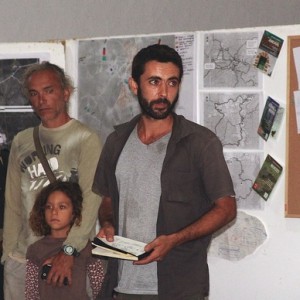Pathways to restoring a non-tourism dependent Algarve.
The small village of Ameixial1, located in the council of Loulé, hosted the presentation ceremony for the final projects resulting from last autumn’s Permaculture Design Course.

This presentation counted on the participation of its fifteen students and the attendance of many of the local citizens who, with a certain degree of reluctance but a lot of curiosity, began getting into, observing and questioning the students about the proposals and solutions that they had “designed”. These appeared on posters dotted around the venue and serving to facilitate the explanation and understanding of terms as varied as water management, energy efficiency, forestation, agricultural production, social inclusion or waste management.
The course itself lasted twelve days running between 6th and 17th September 2014 and counted on the support of the Terra Crua (raw earth) association, Ameixial Parish Council, and the Municipal Councils of Loulé and Almodôvar. Its curriculum featured subjects as varied as the Ethics and Principles of Permaculture, Climates and Microclimates, Natural Succession, Soils, Aquaculture, Edible Forestry, Bioconstruction, Energy Efficiency, Renewable Energies, Sustainable Communities and Social Design.
The course was designed to empower its participants as ethical and regenerative designers and involved the village of Ameixial to the extent that the objects designed were public spaces in the parish council that were either abandoned or poorly made use of. This was the first of many initiatives held under the auspices of this project that sought (successfully) to provide a sample of the systems, models, techniques and strategies that Permaculture may provide a particular location and correspondingly improving the quality of life of its inhabitants and restoring its public spaces. Having been conceived within the scope of the Ameixial (Loulé) and Santa Cruz (Almodôvar) re-settlement and revitalisation initiative, the project under development focuses on repopulating the area through bringing in young persons to work in jobs created in these desertified regions. Therefore, the objectives also include the economic, social and cultural revitalisation of these forgotten and abandoned zones.
The entity organising and running the initiative is the project founder that is the Installation Commission of the Semina Futuri Association. The project also drew upon the participation, support and dynamic inputs from the facilitators Lesley Martin, André Carvalho and Sandra Santos.
For further information on this project, Eco123 talked to Nuno “Mamede” Santos and Mélanie Santos, one of the pioneering couples in this habitation project for the resettlement of the inland regions of Portugal.
ECO123: Names, ages and professions?
Nuno Santos and Mélanie Santos: We are the project’s pioneering inhabitants, currently living in the parish of Santa Cruz (Almodovar). We are 35 and 22 years of age and full-time regenerators.
What did you do before this project started? Where did you work and live?

We held the same occupation but in another part of the country, more specifically in Góis. I (Nuno Santos) have given training in Bioconstruction for a few years now and more recently I have essentially worked in consultancy, design and environment education. Mélanie came from Belgium two years ago where she was involved in an alternative education project and where she had taken her first steps in Permaculture. At the moment, she divides herself between educating our children, studying shiatsu and developing the initial but essential tasks for project implementation.
Could you explain the general project outline
In summary, the project plans to recover a bit of the shine these villages once had within a context of sustainability. Hence, benefitting from the planet, without jeopardising the future, and creating an abundance. We want to attract and settle inhabitants in this region, reversing the rural exodus, lowering unemployment, raising “our” children in a healthy, safe and aware fashion. In fact, everything we have a right to.
Why Ameixial?
In truth, the project involves two parishes divided by a magnificent river, the Vascão, even while the cultural, social, geographic and economic characteristics are the same. These areas have seen deforestation, soil erosion and desertification and thus reflect the greatest need for regeneration projects. Here, there is sharp need for ingenuity, where windows of opportunity are open and where there is the greatest receptivity to new ideas.
Was there much demand?
The course was practically full. And on the presentation evening, we had at least 60 people in attendance.
What ideas did the trainees come up with?
A lot. As I mentioned before, they developed the initial outlines for an entire parish undergoing transition. At the end of the course, the parish’s residents were invited to visit us and come into contact with some of the solutions that the students had designed dealing with issues such as water management, energy efficiency, forestation, agricultural production, social inclusion and waste management, among many other themes that triggered the curiosity of those who turned out for presentation day.
How are they going to be implemented in the field?
All of the ideas are subject to further design, however, the re-settlement has already begun. The majority of the ideas and designs incorporate the active participation of the population as they involve their lands and resources.
And the population, how did they welcome these ideas?
We had good feedback in general. Some initial scepticism was forecast but this was only residual. We were very well received by the local community and, after the course, we were provided with the lands and houses to put the project into practice.
Is this a family level project? How was it possible to ensure the convergence of every member of the household around such a large transition?
Not only families as this is a community project even while somewhat different to those we are used to when thinking about communities. This makes a return to the village based community model but for many villages within the same region.
Do you get any support?
For the meanwhile, we have the support of the Loulé and Almodôvar councils and the inhabitants and local real estate owners.
Is the idea primarily about helping the population improve their living condition or are there other types of profit?
In our perspective, ecological revitalisation is not possible without social and economic revitalisation. These are the three axes to sustainability. If we plant a forest without involving people and without nurturing any financial returns, that forest gets burned or cut down. If there is no form of economic return, there will be nobody willing to tend the forest.
What’s the future for the project? And for Portugal?
This project is essential to the appropriate development of this region. Currently, Portugal is one of the world’s leading examples in terms of the quantity of projects in this context and for two reasons: need and the bond that practically all the Portuguese hold with the rural environment. Should this project get the support it deserves then we have a bright future ahead of us.
How is it possible to establish a balance between ecology and the economy?
 It would seem we do need to bring a little of economics into our ecological projects and as well as a little of ecology to our economic projects. Many environmental project fail because they depend uniquely and exclusively on external financial inputs and prove unable to generate the necessary financial returns. However, on the other hand, any production (even cellulose) may be converted and adapted to bring about the best results in ecological terms.
It would seem we do need to bring a little of economics into our ecological projects and as well as a little of ecology to our economic projects. Many environmental project fail because they depend uniquely and exclusively on external financial inputs and prove unable to generate the necessary financial returns. However, on the other hand, any production (even cellulose) may be converted and adapted to bring about the best results in ecological terms.
We are also in the initial phase of implementation and awaiting the green light for financing and official institutional support. Nevertheless, the revitalisation project for inland Portugal continues to advance with the terrain under preparation in these first twelve months. This initiative may also be accompanied for the meanwhile on its Facebook page and later there will be an official project site. It’s also possible to witness the application of simple and practical techniques and forms of knowledge efficient in both ecological and financial terms.
There is a great deal of expectation and optimism that ECO123 will be accompanying the unfurling of this project. For now, there is the evidence that there is a new generation that is being well influence d and already displaying signs of a greater proximity towards nature. This might well be the example that was lacking to get some people to opt for a future with the quality of life of inland Portugal.
.
Semina Futuri – Association for the Social, Cultural and Ecological Revitalisation of the Algarve
E-mail: seminafuturi@gmail.com
Facebook: www.facebook.com/pages/Semina-Futuri/156052337867069
Ameixial é uma freguesia do concelho de Loulé , com 123,85 km² de área e 439 habitantes (2011). Densidade: 3,5 hab/km².
 Eco123 Revista da Economia e Ecologia
Eco123 Revista da Economia e Ecologia



